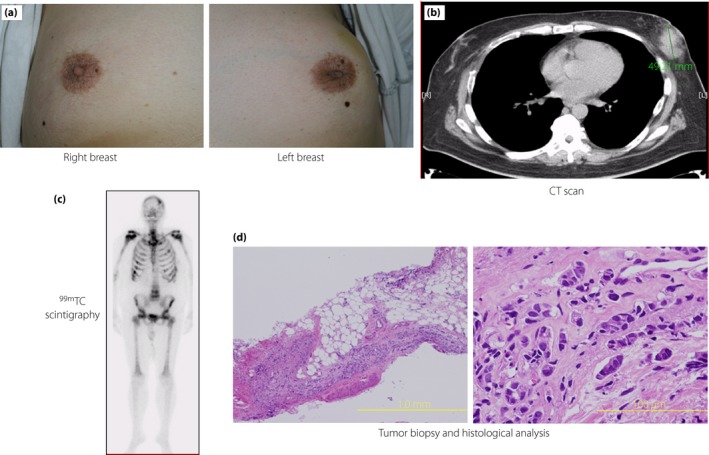Abstract
It is known that male breast cancer is extremely rare and obesity is a strong risk factor of breast cancer in both male and female. In general, the prognosis in breast cancer in males is known to be very poor compared to that in females as it tends to be more advanced stage due to delayed initial diagnosis. Therefore, we should be aware of the possibility that breast cancer could be developed even in relatively young males without any specific risk factors especially when the subjects have severe obesity.

The incidence of breast cancer is markedly increasing in postmenopausal women, and it is likely that obesity is one of the risk factors for breast cancer in such relatively elderly individuals, especially in Asia–Pacific populations1.
In contrast, breast cancer in men is extremely rare (approximately 0.5–1.0% in all breast cancer), and its susceptible age in men is quite high (the 60s and 70s) compared with that in women2, 3. Therefore, many clinicians as well as patients do not pay enough attention for the incidence of breast cancer in men. We herein show a case of a relatively young man who had an advanced breast cancer without any specific risk factors for male breast cancer except for the presence of obesity. A 39‐year‐old man had appetite loss for approximately 5 months, and his bodyweight was markedly reduced from 130 kg to 100 kg during the period. From this time, he noticed a tumor in the left breast. After then, he started having nausea and more severe appetite loss, and finally he visited the hospital. On laboratory examination, his glycated hemoglobin was 14.1%, and his blood glucose level was elevated up to 367 mg/dL. At this point, he was diagnosed with type 2 diabetes for the first time, as his insulin secretory capacity was well preserved (serum immunoreactive insulin level 16.2 μU/mL) and glutamic acid decarboxylase antibody was negative. He was hospitalized for an intensive examination, and treatment of diabetes and breast tumor.
On admission, the patient's height was 162.6 cm, and his bodyweight was 83.8 kg. Basal hormonal levels were checked to rule out secondary obesity and diabetes mellitus. Each hormonal level was as follows; growth hormone 0.12 ng/mL, insulin‐like growth factor‐1 125 ng/mL, adrenocorticotropic hormone 20.2 pg/mL, cortisol 15.4 μg/dL, dehydroepiandrosterone sulfate 232 μg/dL, estradiol 39 pg/mL and free testosterone 13.5 pg/mL, which were all within the normal range. Gynecomastia was observed, and a hard mass with good mobility and border irregularity was palpable in the C region of the left breast (Figure 1a). In addition, two lymph nodes were palpable in the axillary region. Computed tomography also detected the mass in the left breast region, and swelling of the axillary and supraclavicular lymph nodes (Figure 1b).
Figure 1.

(a) Appearance of bilateral breasts with significant nipple retraction in left breast. (b) Left breast tumor detected by computed tomography. (c) Multiple bone metastasis of breast cancer detected by 99mTc scintigraphy. (d) Histological analysis of tumor biopsy.
99mTc scintigraphy showed metastasis to the broad area including the cranial bone, bilateral humeri, clavicles, femurs, ribs, pelvis and vertebrae (Figure 1c). Tumor biopsy and histological analysis were carried out, leading to diagnosis of scirrhous carcinoma (cT2N3M1 stage IV; Figure 1d). The patient had no familial history of breast cancer; disorders of the testicles, such as undescended testes, orchitis and trauma; liver cirrhosis; or exposure to radiation. His physical appearance (relatively low height, normal testicle size) and fertility denied Klinefelter syndrome. Taken together, it was assumed prominent obesity was the strong risk factor in this patient, as no other obvious risk factors existed.
After admission, his blood glucose level was normalized by multiple daily insulin injections. Tamoxifen therapy was started for breast cancer as the estrogen receptor was positive and human epidermal growth factor receptor 2 amplification was not confirmed by a fluorescence in situ hybridization test in the histological analysis.
In the present report, we showed an advanced breast cancer in a relatively young man who had severe obesity and type 2 diabetes mellitus. In general, the prognosis of breast cancer in men is known to be very poor compared with that in women, as it tends to be at a more advanced stage because of delayed initial diagnosis4. Therefore, we should be aware of the possibility that breast cancer can develop even in relatively young men without any specific risk factors, especially when the patients have severe obesity3. It was reported that estradiol was elevated in men with breast cancer compared with men without breast cancer. However, there is no report that defines the cut off value of estradiol to predict male breast cancer. We believe that it is important to inform obese men of the risk of breast cancer and educate self‐palpation for early detection, as there are no appropriate surrogate markers to predict male breast cancer at the present time5.
Disclosure
The authors declare no conflict of interest.
References
- 1. Renehan AG, Tyson M, Egger M, et al Body‐mass index and incidence of cancer: a systematic review and meta‐analysis of prospective observational studies. Lancet 2008; 371: 569–578. [DOI] [PubMed] [Google Scholar]
- 2. PDQ Adult Treatment Editorial Board . Male Breast Cancer Treatment (PDQ®): Health professional Version 2016 Feb 12.
- 3. Brinton LA, Richesson DA, Gierach GL, et al Prospective evaluation of risk factors for male breast cancer. J Natl Cancer Inst 2008; 100: 1477–1481. [DOI] [PMC free article] [PubMed] [Google Scholar]
- 4. Giordano SH, Buzdar AU, Hortobagyi GN. Breast cancer in men. Ann Intern Med 2002; 137: 678–687. [DOI] [PubMed] [Google Scholar]
- 5. Brinton LA, Key TJ, Kolonel LN, et al Prediagnostic Sex Steroid Hormones in Relation to Male Breast Cancer Risk. J Clin Oncol 2015; 20: 2041–2050. [DOI] [PMC free article] [PubMed] [Google Scholar]


